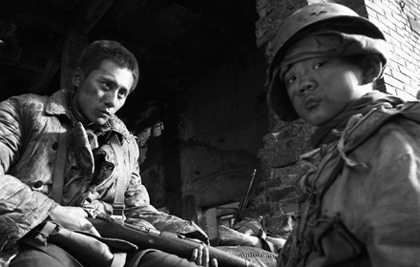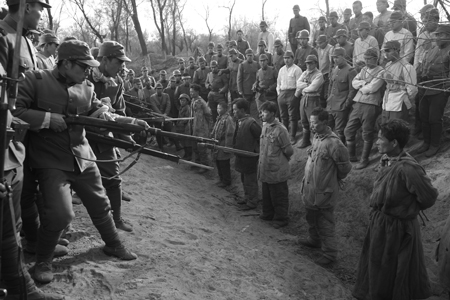
 |
|
|
|
Lu Chuan's City of Life and Death (Nanjing! Nanjing!) was a leading performer at the Chinese box office in 2009. It earned plenty of approval from overseas critics, many of which conceivably know little about its horrific subject. One of the most influential images of the 20th century is a photo image of a Chinese baby, sitting orphaned and abandoned in the wreckage of a burning city. 72 years later, the Nanking (now Nanjing) Massacre has become a political reference point when referring to Japanese atrocities before and during WW2. In only a few short weeks, the Imperial Japanese Army slaughtered 300,000 Chinese soldiers and civilians. For Americans of my parents' generation, this event and The Bataan Death March were central issues when the subject of Japan came up in conversation. The massacre has been visited many times in Chinese films that mix moral messages with nationalistic propaganda. Writer-director Lu Chuan's film dispenses with politics beyond the scope of the actual participants. In fact, the film limits our view of the massacre to the point of view of the victims on the ground. Everything seems to be happening in the present tense, as an impossibly brutal spectacle that leaves everyone, even some of the Japanese perpetrators, in shock. Chuan Lu films in B&W 'scope, the better to avoid "pretty" pictorial effects -- as well as tone down the more brutal scenes. 
The 'rape of Nanjing' begins as a military success for the Japanese. As the siege troops sweep in, the Chinese defenders split up into factions, as some units mutiny. The Japanese put down the final resistance harshly. When that is broken, the charismatic guerilla leader Lu (Liu Ye) watches as his captured comrades -- thousands of them -- are executed en masse by whatever means are expedient: machine guns, burning, drowning, being buried alive. In the occupation that follows all rules of conduct seem to be forgotten. Japanese soldiers shoot whomever they encounter on the street, and rape and murder women. Young officer Ida (Ryu Kohata) discourages none of this. Among the victors, only the conscience stricken Kadokawa (Hideo Nakaizumi) seems in the least concerned. The troops have been fighting for months; one Japanese general speaks as if the right to rape and slaughter is a matter of morale, an entitlement. The general population, as they are caught, are all killed. Bodies hang from light standards and we see many human heads hanging like fruit on trees. The martial culture treats defeated enemies as so much vermin to be exterminated. The film's second part shows a German compound called the Safety Zone, supposedly set aside to protect the workers of the German representative John Rabe (John Paisley). Rabe is a Nazi, but he offers the only hope for many and is soon providing sanctuary for outsiders, including wounded soldiers. Mr. Tang (comedian Wei Fan) is Rabe's secretary. He negotiates in good faith with the Japanese authorities to protect his young child, older daughter, wife and sister-in-law. The efforts are in vain, and his experience is a succession of horrors. For the occupying army, mass rape is the accepted form of rest and recreation. The Japanese have their own comfort women and regular Chinese prostitutes, but they demand 100 additional Chinese women from the Safety Zone to provide sex for the soldiers, supposedly for a limited time of two weeks. Many women are literally raped to death; their bodies are dragged out as if they were dead animals. The Japanese do not honor their agreements with Mr. Tang. His special waivers prove useless when the soldiers come for his daughter and sister-in-law. Meanwhile, soldier Kadokawa is having trouble reconciling what he's witnessing. He has close emotional ties to one of the comfort women, Yuriko (Yuko Miyamoto). She remains aloof to him, and he later claims that they had a special relationship before the war. 
In the final chapters of the story, Representative Rabe is asked to leave, as his protests are causing diplomatic troubles between Berlin and Tokyo. The Japanese make various promises, but nobody in the Safety Zone expects to be allowed to leave. A couple of American teachers and Miss Jiang (Yuanyuan Gao) a Christian teacher, scheme to save as many as possible. Kadokawa is unnerved by the ruthlessness of it all. City of Life and Death rates high marks for the way it presents its violence -- it is direct, bloody and matter of fact, as in Roman Polanski's The Pianist. By now we're accustomed to seeing mass killings in films (or on the TV news, for that matter) but the scale here is frightening. The Japanese herd their victims in groups of two hundred or more to various awful fates, each worse than the next. The story doesn't shy away from the violence to women, who are repeatedly raped in thrown-together facilities like cubicles. We see their bodies being carted away in wheelbarrows. In a bizarre contrast, the Japanese celebrate their victory with an elaborate pageant involving giant drums, regimented singing and dance-marching. The film's overall effect can be overwhelming, but not so much that we don't see the calculation in the presentation. We see wounded men in hospital beds shot through their bandages, but the movie doesn't overload us with two many individual agonies -- once we get the idea, director Lu backs off -- this is a horrifying film, but not a horror film. We are informed that Chuan's original full cut contained a scene of mass beheadings, but that scenes of this kind were censored by the Chinese authorities. The calculations come with identification figures carefully gauged to steer our emotions. The "good" Japanese soldier Kadowkawa seems a sop to remind us that Japanese aren't intrinsically evil. Kadokawa is like the "good German" played by Marlon Brando in The Young Lions, the Cold War compromise seemingly concocted to curry favor with our new West German allies. The Japanese Army would not for a second tolerate anything like real dissent, so this soul-sick Kadokawa must keep his feelings hidden. City of Life and Death presents the unchanging truth of warfare, which even when conducted "by the rules" is a succession of brutal atrocities. Its presentation of a worst-case historical event is by and large uncompromised. But the filmmakers can't resist the commercial impulse to give the audience a morale boost, a sign of hope. A pair of miraculously survived Chinese laugh as they walk to safety and the "moral" Japanese soldier chooses a poetic way to "exit the killing field". Viewers shaken by the film's violence may welcome these gestures. None of them is outright impossible, as even in the hellish Rape of Nanking small miracles surely occurred. But they're still only slightly more refined than the old clichés of honor and "meaningful" sacrifice. 
Chuan's film will send a lot of viewers to the web to look up "Nanjing Massacre", as the film offers almost no political detail and no context. Casual viewers are not given a clue as to why the Japanese were invading China, and will probably not realize that WW2 hasn't started yet. We often don't know what we're looking at. Do those starburst patterns on helmets represent Chiang Kai Shek's Nationalists? And is the flag with the narrow cross a Red Cross Flag, or does it represent the German Safety Zone? In terms of balance between a personal story and a wider appreciation of the utter barbarity of WW2 in Asia, the best film I've seen is still Masaki Kobayashi's The Human Condition. City of Life and Death is a humbling and pessimistic statement about war in general, and an incitement for the curious to read more about 20th century history. It's a well made, riveting experience for those not already desensitized by "fantasy" violence in modern entertainment. Kino Lorber's Blu-ray of City of Life and Death is an excellent encoding of this B&W picture, which plays out as a very realistic nightmare. Image and audio are strong. I've read reviews that praise the film's music score for not emphasizing every violent act. The music I hear makes a conventional contribution, and does do its fair share of mood enhancement and emotional direction. The set comes with a second disc containing Matters of Life and Death, a making-of film that runs just under two hours. As an account of a wildcat Chinese director defying all odds to produce an impressive, large-scale epic, it's fascinating. Director Chuan was plagued by health problems throughout the shoot -- we see plenty of scenes being filmed in sub-zero temperatures, including scores of nude corpses (played by living actors) being carted away. The actors come on screen to assure us of the film's importance, and the overall message is that this is the greatest picture ever made. We don't get that much more historical background, although Chuan's attention to detail is remarkable. I think this film is extremely worthy.
On a scale of Excellent, Good, Fair, and Poor,
City of Life and Death Blu-ray rates:
Reviews on the Savant main site have additional credits information and are often updated and annotated with reader input and graphics. Also, don't forget the 2011 Savant Wish List. T'was Ever Thus.
Review Staff | About DVD Talk | Newsletter Subscribe | Join DVD Talk Forum |
| ||||||||||||||||||